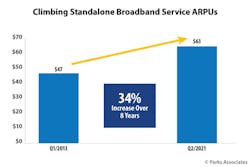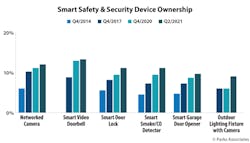This article originally appeared in the November 2021 issue of Security Business magazine. When sharing, don’t forget to mention Security Business magazine on LinkedIn and @SecBusinessMag on Twitter.
There is a new reality for work and school for consumers that creates a ripe environment for home networking and Wi-Fi solutions. Our recent consumer data from the end of 2020 shows that 26% of individuals in broadband households are now working remotely – both all-time and part-time – with 18% working remotely with another adult in the household. In addition, 41% of broadband households reported children attending school remotely.
8.4 in 2015 to 14.0 in 2021 – 67% growth over just six years. As of Q2 2021, 36% of broadband households report owning a “smart home” device, ranging from smart light bulbs, voice assistants, smart doorbells, smart locks and numerous other devices.
While the smart home market as a whole has shown some growth, the consumer-reported adoption rate for many individual smart home devices has remained consistent over the past four years.
As data security needs for the connected home increase, opportunities exist across the ecosystem to cultivate partnerships with device and system manufacturers, broadband operators and security solution providers to develop solid solutions that minimize the likelihood of cybersecurity breaches.
Smart security devices are often self-installable devices that have a variety of relationships with professionally installed systems. Numerous incidents have proven that smart home security devices are vulnerable without proper precautions. Data generated by smart devices provide cyber attackers with ample sensitive information that can be exploited via social engineering for fake transactions and identify theft.
Consumers Hungry for Better Broadband Speed
As a result of all the activity on the network, consumers are taking matters into their own hands with their broadband speeds, and increasing their services. Parks Associates data reveals nearly 10% of consumers reported signing up for faster Internet speeds with a more expensive plan, with only 3% of consumers downsizing their Internet speed plans from a service provider, even at a lower cost. Faster speeds in the 100 Mps to 1 Gbps band has climbed 19% in 2015 to 36% in 2019, a 90% increase.
We have also seen a continued trend of standalone home broadband service ARPU levels are on the rise. ARPU for standalone home broadband service has risen from $47 in Q213 to $63 in Q2 2021, a 34% increase over eight years.
Consumers access broadband at home in a variety of ways – from traditional coaxial-based Ethernet, to smartphone-based hot spots, to fiber optic and emerging 5G access. Consumers often employ multiple broadband access approaches for flexibility, cost and convenience considerations. Versus prior periods, Ethernet and smartphone-based broadband access are the leading connection vehicles, with 5G gaining steam in early 2021.
Slow speed and Wi-Fi interruptions are understood to be top reasons driving home network devices upgrades, followed by coverage issues, device connectivity issues and initial setup/configuration problems. When we deep dive into the core reasons why broadband households are upgrading their home network devices, a compelling 56% of consumers surveyed report that they experienced at least one technical issue in the past. This environment presents a considerable opportunity for service providers who can offer a “managed Wi-Fi” approach that positions the ISP as a trusted CTO-like entity who can provide worry free problem solving, automatic firmware upgrades and even parental controls.
Wi-Fi is, and has been, the dominant method for how consumers access the Internet in their homes. As faster Wi-Fi protocols have been adopted in routers, PCs, smartphones and other devices, wireless access speeds are becoming as nearly compelling as wired access. This trend has been ongoing for many years and is unlikely to change.
As we look forward, the tailwinds for home networking devices are very strong. While the pandemic has had an accelerant-like impact on purchase intention levels for new routers, Wi-Fi extenders and mesh-based router system solutions, usage models will play a significant role as well.
The pandemic has affected the way consumers live and work, creating a need for advanced functionality and new services and capabilities built into their home gateways. Meeting these new technology needs will position service providers as a trusted technical support entity in consumers’ households and leaders in the home networking space.
Elizabeth Parks is the President of market research firm Parks Associates. For more information about Parks Associates broadband and home networking research, visit www.parksassociates.com.




